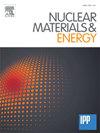Helium retention feature in the boron deposited layer on tungsten substrate by laser-induced breakdown spectroscopy and machine learning approach
IF 2.3
2区 物理与天体物理
Q1 NUCLEAR SCIENCE & TECHNOLOGY
引用次数: 0
Abstract
ITER is designed for a burning plasma operation in which Tungsten (W) tiles are used as the first wall and diverter materials. Studying He dynamics in B-coated W wall is essential to understanding the effect of boronized plasma-facing components in fusion reactors, as these post-conditioning materials significantly influence helium retention and release. Plasma-wall interactions (PWI) are an important issue in ITER fusion reactors. PWI would lead to wall erosion and impurity redeposition. As a product of the D-T burning plasma, helium (He) ash would be retained or co-deposited on plasma-facing components (PFCs), affecting the stable operation of burning plasma. Laser-induced breakdown spectroscopy (LIBS) is proposed as a promising in-situ diagnostic approach for monitoring D/T and He retention and impurity deposition on PFCs of tokamak devices. In this study, the LIBS technique was used to investigate the helium retention feature in the boron (B) layer on tungsten substrate in 10−5 mbar. Five He-retention samples on the boron deposition layer on tungsten substrates were prepared by pulsed laser deposition (PLD) method at different ambient pressures in our lab. The investigations indicate that the atomic spectral line of helium (He-I 587.56 nm) was observed in the spectra of the first three laser shots. The depth profiles of He, B, and W in the boron-deposited layer on tungsten substrate were performed by LIBS to determine the co-deposition layer thickness. The concentration of He in the co-deposition layer samples measured by TDS is 7 × 1020 He/m2. The plasma parameters, such as plasma electron temperature and electron number density, were calculated to validate the local thermodynamic equilibrium. Machine learning (ML) algorithms are used to classify the co-deposits and substrates. The first three principal components (PC1, PC2 & PC3) of the unsupervised ML algorithm (PCA) give a classification accuracy of 91.7 %. The supervised ML algorithm neural network achieved training and testing accuracy of 100 % and 96.7 %, respectively.

通过激光诱导击穿光谱和机器学习方法分析钨基板上硼沉积层的氦保留特征
国际热核聚变实验堆设计用于燃烧等离子体运行,其中钨(W)瓦被用作第一壁和分流器材料。研究硼涂层 W 壁中的氦动力学对于了解聚变反应堆中面向等离子体的硼化组件的效果至关重要,因为这些后处理材料会显著影响氦的保留和释放。等离子体-壁相互作用(PWI)是热核聚变实验堆中的一个重要问题。等离子体-壁相互作用会导致壁侵蚀和杂质再沉积。作为 D-T 燃烧等离子体的产物,氦(He)灰将保留或共同沉积在面向等离子体的部件(PFC)上,从而影响燃烧等离子体的稳定运行。激光诱导击穿光谱(LIBS)被认为是一种很有前途的原位诊断方法,可用于监测托卡马克装置 PFC 上的 D/T 和 He 残留及杂质沉积。在本研究中,我们使用 LIBS 技术研究了钨基底上硼(B)层在 10-5 毫巴条件下的氦滞留特征。本实验室在不同的环境压力下,采用脉冲激光沉积(PLD)方法制备了钨衬底上硼沉积层的五个氦保留样品。研究结果表明,在前三次激光发射的光谱中观察到了氦的原子光谱线(He-I 587.56 nm)。利用 LIBS 对钨基板上硼沉积层中 He、B 和 W 的深度剖面进行了分析,以确定共沉积层的厚度。通过 TDS 测量的共沉积层样品中 He 的浓度为 7 × 1020 He/m2。计算了等离子体参数,如等离子体电子温度和电子数密度,以验证局部热力学平衡。使用机器学习(ML)算法对共沉积层和基底进行分类。无监督 ML 算法(PCA)的前三个主成分(PC1、PC2 & PC3)的分类准确率为 91.7%。有监督 ML 算法神经网络的训练和测试准确率分别为 100 % 和 96.7 %。
本文章由计算机程序翻译,如有差异,请以英文原文为准。
求助全文
约1分钟内获得全文
求助全文
来源期刊

Nuclear Materials and Energy
Materials Science-Materials Science (miscellaneous)
CiteScore
3.70
自引率
15.40%
发文量
175
审稿时长
20 weeks
期刊介绍:
The open-access journal Nuclear Materials and Energy is devoted to the growing field of research for material application in the production of nuclear energy. Nuclear Materials and Energy publishes original research articles of up to 6 pages in length.
 求助内容:
求助内容: 应助结果提醒方式:
应助结果提醒方式:


